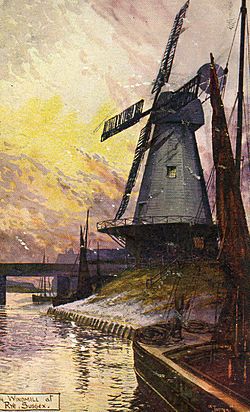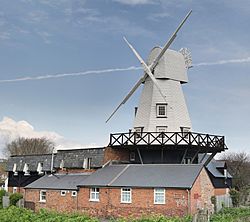Gibbet Mill, Rye facts for kids
Quick facts for kids Rye Windmill |
|
|---|---|
 
Gibbet Mill from an old postcard, artist - Walter Hayward-Young (above) and the mill in 2009 (below)
|
|
| Origin | |
| Mill name | Gibbet Mill Tillingham Mill Barry's Mill New Mill |
| Mill location | TQ 917 203 |
| Coordinates | 50°57′00″N 0°43′41″E / 50.950°N 0.728°E |
| Operator(s) | Private |
| Year built | 1824 |
| Information | |
| Purpose | Corn mill |
| Type | Smock mill |
| Storeys | Four-storey smock |
| Base storeys | Single-storey base |
| Smock sides | Eight sides |
| No. of sails | Four sails |
| Type of sails | Spring sails |
| Windshaft | Cast iron |
| Winding | Fantail |
| Fantail blades | Eight blades |
| No. of pairs of millstones | Three pairs |
| Year lost | 1932 |
| Other information | Replica body constructed on original base. |
Rye Windmill, also known by names like Gibbet Mill or Barry's Mill, is a special building in Rye, England. It's a type of windmill called a smock mill. Today, it's not used for grinding grain anymore. Instead, it's a cozy bed and breakfast where people can stay. This mill is a Grade II listed building, which means it's an important historical site.
Contents
The Mill's Story: A Look Back in Time
A mill has stood on this spot for a very long time, since 1596. We know that a post mill was built here in 1758. The mill we see today, called Gibbet Mill, was first built in 1824. It got the name Barry's Mill from one of its early millers.
This windmill worked using wind power until 1912. After that, it was used as a bakery. Sadly, on June 13, 1930, the mill burned down. But people wanted to rebuild it! A new mill was put up in 1932. A company called Neve's from Heathfield did the special building work.
What Rye Windmill Looks Like
Original Design
When Gibbet Mill was first built, it was a four-story smock mill. It sat on a single-story brick base. There was also a platform, or "stage," at the first-floor level. In 1844, it had four Patent sails. Later, it used four Spring sails, which are a different type. These sails were connected to a strong cast-iron shaft. The top part of the mill, called the cap, was in a style common in Kent. It had a special fantail that would turn the cap to face the wind. Inside, the mill had three pairs of millstones to grind grain.
The Rebuilt Mill Today
The mill you see today is a replica, meaning it's a copy of the original. It doesn't look exactly like a working windmill. The main body of the mill is shorter, making it look a bit squatter than the first one. The cap on top is also taller than it used to be. This cap isn't designed to turn into the wind like a real working mill's cap would. The replica also has fake sails and a fake fantail. The platform around the mill is wider than the original one was.
Who Worked the Mill?
Many people worked at Rye Windmill over the years. Here are some of the millers who helped grind grain:
- Frederick Barry: 1824 - 1844
- John Smith: 1848 - 1879
- Gorge Standed: 1882 - 1899
- Webb: 1917
Images for kids


